#Infrared thermal imaging
Text
Forlinx FET3588-C SoM Facilitating the Intelligent Development of Infrared Thermal Imaging
According to Maxtech International data, the global civil infrared market size will exceed 7.6 billion US dollars in 2023, and in the past four years, the infrared industry has maintained a growth rate of over 11%. Moreover, according to data from Huajing Industrial Research Institute, the market size of China's infrared thermal imaging industry reached 65.534 billion yuan in 2021.
With the development of non-cooled infrared thermal imaging technology, infrared thermal imagers have been widely used in civil applications. This statement is attributed to Huajing Industrial Research Institute.
Against this backdrop, manufacturers and institutions that specialize in the research and production of infrared thermal imaging products have begun to lay out strategies for the civilian infrared thermal imaging market, which is a blue ocean market. The breast surgery research team from Peking Union Medical College Hospital in Beijing has applied their independently developed artificial intelligence-based infrared thermal imaging system (AI-IRT) to pre-screening for breast cancer.
The team has also developed a portable AI-IRT system, which includes an infrared miniature camera connected to a smartphone, AI software, and a real-time updated infrared thermal imaging database.
When using this system for pre-screening of breast cancer, the real-time captured infrared thermal images of the breasts are uploaded to the artificial intelligence software, which then provides a risk assessment rating. The system is non-invasive, radiation-free and easy to use, and can be used in families and community health service centers for screening.
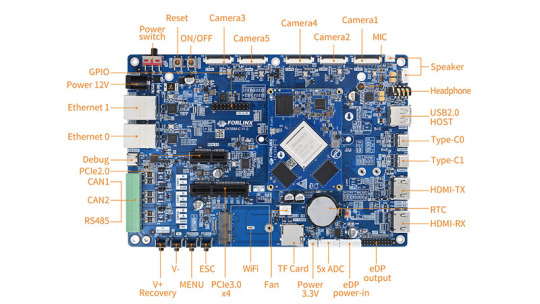
Infrared thermal imaging can be used as an electrical equipment monitoring system, which is installed around the transformer, etc. Through optical fiber transmission, the monitoring of equipment can be completed in the monitoring room. 24 hours, all-weather, full coverage of all substation power equipment for real-time monitoring of thermal distribution field, real-time grasp of equipment operation status, found abnormal temperature rise immediately alarm.
In addition to equipment monitoring, it is also widely used in substation inspection, distribution inspection, transmission and distribution cable inspection industry, so that inspectors can grasp the temperature while helping the power industry inspection work become more efficient and easier.
In order to adapt to the development of infrared thermal imaging industry, Forlinx Embedded recommends FET3588-C System on Module(SoM) as the main control of highly integrated infrared thermal imager.
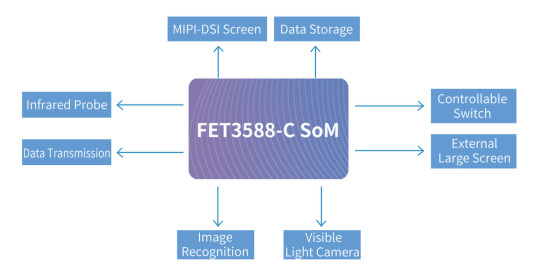
FET3588-C has 8K video codec + 8K display supporting 8K @ 60fps H.265 and VP9 decoders, 8K @ 30fps H.264 decoders and 4K @ 60fps AV1 decoders, supporting 8K @ 30fps H.264 and H.265 encoders. High quality JPEG encoder/decoder.
Optimization of 12V power supply can reduce losses, while PMIC dynamic frequency scaling can improve stability.
Powerful: Quad-core Cortex-A76 + Quad-core Cortex-A55, main frequency height of 2.4 GHZ, NPU with 6 TOPS
Support multi-channel video access and display output
Complete functional interfaces such as mipi-csi, mipi-dsi, USB, SATA, UART, CAN and Gigabit Ethernet
Originally published at www.forlinx.net.
0 notes
Text
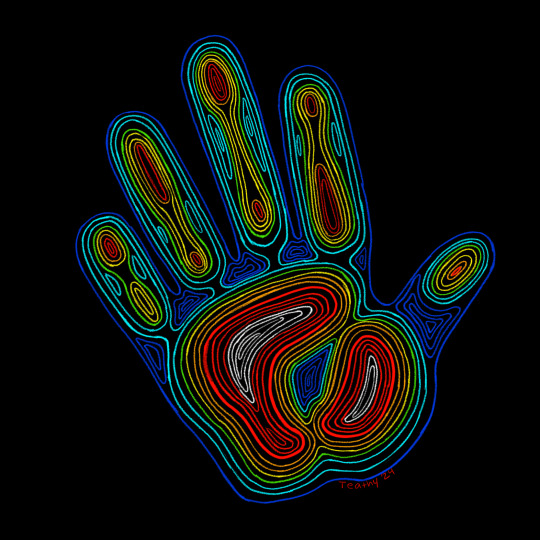
Hand‼️
#my art#art#digital art#sketch#yeah#clip studio paint#csp#doodles#teathy24#teathy 24#heat signature#infrared#thermal#thermal imaging#hand#I like drawing little lines it’s fun!!#very tedious but fun
2 notes
·
View notes
Text
Professional Thermal Imaging Inspection in Montreal – Thermoelite
Looking for reliable and accurate thermal imaging inspection in Montreal? Look no further! At Thermo elite, we offer professional thermal imaging services to help you identify hidden problems in your home or commercial property. Whether it's detecting heat loss, moisture infiltration, or electrical faults, our expert team uses cutting-edge infrared technology to give you precise results.
Why Choose Thermoelite for Thermal Imaging Inspections?
At Thermo elite, we are committed to providing top-notch thermal imaging inspections that help property owners address potential issues before they turn into costly repairs. Here’s why you should choose us for your next inspection:
Expertise: With years of experience, our certified thermographers are equipped to handle both residential and commercial inspections.
Advanced Technology: We use state-of-the-art infrared cameras to provide clear, detailed thermal images that reveal hidden problems.
Accurate Diagnosis: From moisture leaks to insulation problems, our thermal imaging accurately detects issues that are invisible to the naked eye.
Cost-Effective Solutions: Early detection of problems helps save money on repairs and energy bills by addressing inefficiencies quickly.
What is Thermal Imaging Inspection?
Thermal imaging, also known as infrared thermography, is a non-invasive method that uses infrared cameras to detect heat patterns and temperature differences within a structure. This technology allows us to identify issues that may not be visible during a regular inspection, including:
Moisture Leaks: Detects hidden water leaks in walls, ceilings, and floors.
Electrical Faults: Identify overheating electrical components that could lead to fire hazards.
Insulation Problems: Find areas with poor or missing insulation, leading to energy loss.
Roof Leaks: Pinpoint areas of roof damage or water infiltration before they cause further damage.
Our Thermal Imaging Inspection Services in Montreal
At Thermo elite, we provide a range of thermal imaging inspection services tailored to meet the unique needs of your property:
Home Inspections: Identify potential energy inefficiencies, leaks, and structural issues before buying or selling a home.
Commercial Inspections: Ensure your commercial building is safe and efficient with detailed thermal inspections.
Roof Inspections: Pinpoint roof leaks and insulation problems, preventing costly repairs down the line.
Moisture Detection: Our thermal imaging detects water intrusion in basements, walls, and ceilings, helping you avoid mold and structural damage.
Why Thermal Imaging Inspection is Crucial for Montreal Properties
With Montreal’s variable climate, thermal imaging inspections are essential to maintaining the energy efficiency and structural integrity of buildings. Cold winters and warm summers can take a toll on properties, and our infrared technology helps:
Detect heat loss, ensuring your home stays warm during the winter.
Identify areas of air leakage that may be increasing energy costs.
Prevent potential water damage caused by undetected leaks.
0 notes
Text

Arch Home Inspections Inc. provides indoor air quality (IAQ) tests in Vancouver and the Lower Mainland to ensure a healthy living environment by assessing the quality of the air inside homes and buildings. We have a team of skilled professionals who conduct thorough examinations, analyzing factors such as ventilation, pollutants, and humidity levels. Through precise testing, these services identify potential issues like mold, allergens, or volatile organic compounds that may impact respiratory health. By providing actionable insights, IAQ tests empower residents to take proactive measures, enhancing the overall well-being of their indoor spaces in Vancouver and the surrounding Lower Mainland area. More details at www.archhomeinspections.com
#Indoor Air Quality Test Vancouver and Lower Mainland#Thermal Imaging Inspections Vancouver#Infrared Inspection Vancouver#Commercial Property Inspection Vancouver and Lower Mainland#Home Inspections Surrey#Home Inspections Langley
0 notes
Text
#Thermal Imaging Sensors Market Size#FLIR Thermal Binoculars Share#Best Thermal Binoculars News#Military Thermal Optics Trends#Thermal Imaging Devices#Infrared Binoculars Size
0 notes
Text
Thermal Infrared Imagers Market Research Report 2028

The Global Thermal Infrared Imagers Market Size was estimated at USD 5896.30 million in 2021 and is projected to reach USD 8078.00 million by 2028, exhibiting a CAGR of 4.60% during the forecast period.
Organic Market Research report provides a deep insight into the global Thermal Infrared Imagers market covering all its essential aspects. This ranges from a macro-overview of the market to micro details of the market size, competitive landscape, development trend, niche market, key market drivers and challenges, SWOT analysis, Porter’s five forces analysis, value chain analysis, etc.
The analysis helps to shape the competition within the industries and strategies for the competitive environment to enhance the potential profit. Furthermore, it provides a simple framework for evaluating and accessing the position of the business organization. The report structure also focuses on the competitive landscape of the Global Thermal Infrared Imagers Market.
Thermal Infrared Imager, also can be called thermal imaging infrared camera, is a device that using infrared radiation, similar to a common camera that forms an image using visible light.
In a word, this report is a must-read for industry players, investors, researchers, consultants, business strategists, and all those who have any kind of stake or are planning to foray into the Thermal Infrared Imagers market in any manner.
Download Free Sample Report
Global Thermal Infrared Imagers Market: Market Segmentation Analysis
The research report includes specific segments by region (country), manufacturers, Type, and Application. Market segmentation creates subsets of a market based on product type, end-user or application, Geographic, and other factors. By understanding the market segments, the decision-maker can leverage this targeting in the product, sales, and marketing strategies. Market segments can power your product development cycles by informing how you create product offerings for different segments.
Key Company
FLIR Systems Inc.
L3Harris Technologies, Inc.
Lockheed Martin
Thales Group
GUIDE INFRARED
Fluke Corporation
BAE Systems
DALI TECHNOLOGY
MSA Safety Incorporated
SATIR
Elbit Systems
Testo SE & Co. KGaA
HIKVISION
NEC Corporation
FOREIC
Bullard
Keysight Technologies, Inc.
Market Segmentation (by Type)
Uncooled Thermal Imaging Imagers
Cooled Thermal Imaging Imagers
Market Segmentation (by Application)
Civil
Military
Geographic Segmentation
North America (USA, Canada, Mexico)
Europe (Germany, UK, France, Russia, Italy, Rest of Europe)
Asia-Pacific (China, Japan, South Korea, India, Southeast Asia, Rest of Asia-Pacific)
South America (Brazil, Argentina, Columbia, Rest of South America)
The Middle East and Africa (Saudi Arabia, UAE, Egypt, Nigeria, South Africa, Rest of MEA)
Key Benefits of This Market Research:
• Industry drivers, restraints, and opportunities covered in the study
• Neutral perspective on the market performance
• Recent industry trends and developments
• Competitive landscape & strategies of key players
• Potential & niche segments and regions exhibiting promising growth covered
• Historical, current, and projected market size, in terms of value
• In-depth analysis of the Biobased Transformer Oil Market
• Overview of the regional outlook of the Biobased Transformer Oil Market:
Key Reasons to Buy this Report:
• Access to date statistics compiled by our researchers. These provide you with historical and forecast data, which is analyzed to tell you why your market is set to change
• This enables you to anticipate market changes to remain ahead of your competitors
• You will be able to copy data from the Excel spreadsheet straight into your marketing plans, business presentations, or other strategic documents
• The concise analysis, clear graph, and table format will enable you to pinpoint the information you require quickly
• Provision of market value (USD Billion) data for each segment and sub-segment
• Indicates the region and segment that is expected to witness the fastest growth as well as to dominate the market
• Analysis by geography highlighting the consumption of the product/service in the region as well as indicating the factors that are affecting the market within each region
• Competitive landscape which incorporates the market ranking of the major players, along with new service/product launches, partnerships, business expansions, and acquisitions in the past five years of companies profiled
• Extensive company profiles comprising of company overview, company insights, product benchmarking, and SWOT analysis for the major market players
• The current as well as the future market outlook of the industry concerning recent developments which involve growth opportunities and drivers as well as challenges and restraints of both emerging as well as developed regions
• Includes in-depth analysis of the market from various perspectives through Porter’s five forces analysis
• Provides insight into the market through Value Chain
• Market dynamics scenario, along with growth opportunities of the market in the years to come
6-month post-sales analyst support
About Us:
Organic Market Research Business Consulting is a fast-growing Market Research organization which is helping organizations to optimize their end-to-end research processes and increase their profit margins.
Organic Market Research facilitates clients with syndicate research reports and customized research reports on 10+ industries with global as well as regional coverage.
Mob : +91 9319642100
Noida One Tower Sec 62 Noida 201301
Sales : [email protected]
Website : https://www.organicmarketresearch.com
0 notes
Text
Global Hydrogen Circulation Pump Market Size & share Forecast 2022.

Thermal Infrared Imager, also can be called thermal imaging infrared camera, is a device that using infrared radiation, similar to a common camera that forms an image using visible light.
0 notes
Photo

Professional Infrared Imaging in Newnan
Our infrared thermal imaging services in Newnan are here to detect even the slightest of defects in your future home. Our latest technology allows our inspectors to come across all sorts of defects in the house you are planning to buy. Visit us to book an inspection.
0 notes
Text
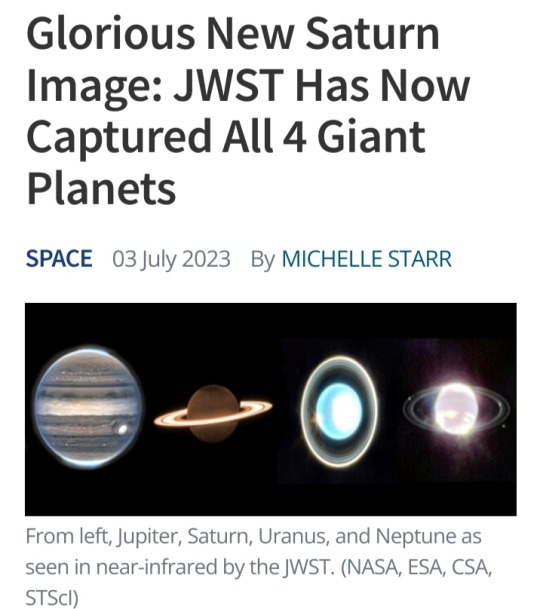
With the addition of Saturn, the James Webb Space Telescope has finally captured all four of our Solar System's giant worlds.
JWST's observations of the ringed planet, taken on 25 June 2023, have been cleaned up and processed, giving us a spectacular view of Saturn's glorious rings, shining golden in the darkness.
By contrast, the disk of Saturn is quite dark in the new image, lacking its characteristic bands of cloud, appearing a relatively featureless dim brown.
This is because of the wavelengths in which JWST sees the Universe – near- and mid-infrared.
These wavelengths of light are usually invisible to the naked human eye, but they can reveal a lot.
For example, thermal emission – associated with heat – is dominated by infrared wavelengths.
When you're trying to learn about what's going on inside a planet wrapped in thick, opaque clouds, studying its temperature is a valuable way to go about it.
Some elements and chemical processes emit infrared light, too. Seeing the planets of the Solar System in wavelengths outside the narrow range admitted by our vision can tell us a lot more about what they have going on.
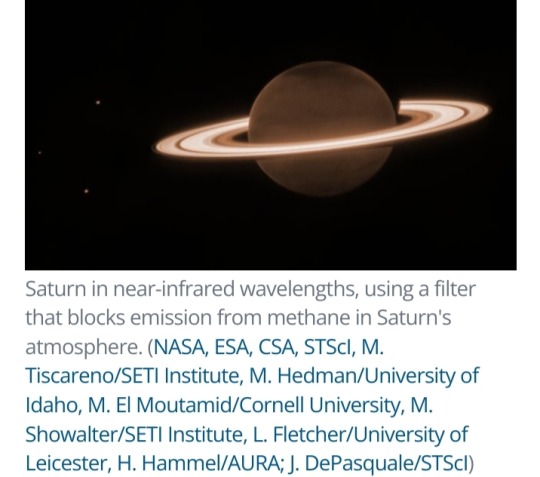
Saturn
As we saw last week, when we clapped eyes on the raw JWST Saturn images, the observations involved filters that dimmed the light of the planet, while allowing light from the rings and moons to shine brightly.
This is so a team led by planetary scientist Leigh Fletcher of the University of Leicester in the UK can study the rings and moons of Saturn in more detail.
They hope to identify new ring structures and, potentially, even new moons orbiting the gas giant.
The image above shows three of Saturn's moons, Dione, Enceladus and Tethys, to the left of the planet.
Although dim, the disk of the planet also reveals information about Saturn's seasonal changes.
The northern hemisphere is reaching the end of its 7-year summer, but the polar region is dark. An unknown aerosol process could be responsible.
Meanwhile, the atmosphere around the edges of the disk appears bright, which could be the result of methane fluorescence, or the glow of trihydrogen, or both. Further analysis could tell us which.

Jupiter
Jupiter was the first of the giant planets to get the JWST treatment, with images dropping in August of last year – and boy howdy were they stunning.
The spectacular detail seen in the planet's turbulent clouds and storms was perhaps not entirely surprising.
However, we also got treated to some rarely seen features: the permanent aurorae that shimmer at Jupiter's poles, invisible in optical wavelengths, and Jupiter's tenuous rings.
We also saw two of the planet's smaller, lesser-known moons, Amalthea and Adrastea, with fuzzy blobs of distant galaxies in the background.
"This one image sums up the science of our Jupiter system program, which studies the dynamics and chemistry of Jupiter itself, its rings, and its satellite system," said astronomer Thierry Fouchet of Paris Observatory in France, who co-led the observations.
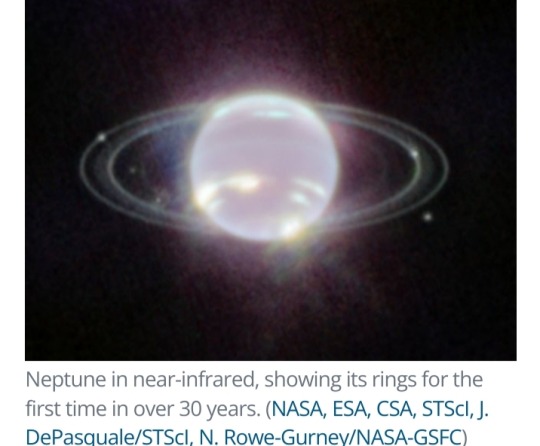
Neptune
Observations of Neptune arrived in the latter half of September 2022.
Because Neptune is so very far away, it tends to get a little neglected; you're probably used to seeing, if anything, the images taken by Voyager 2 when it flew past in 1989.
JWST's observations gave us, for the first time in more than 30 years, a new look at the ice giant's dainty rings – and the first ever in infrared.
It also revealed seven of Neptune's 14 known moons, and bright spots in its atmosphere.
Most of those are storm activity, but if you look closely, you'll see a bright band circling the planet's equator.
This had never been seen before and could be, scientists say, a signature of Neptune's global atmospheric circulation.
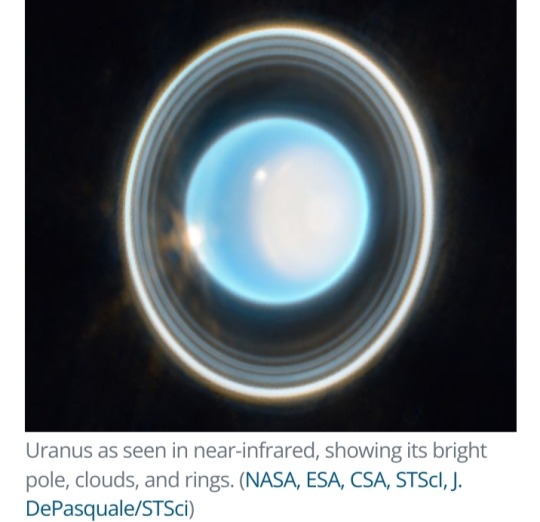
Uranus
Uranus is also pretty far away, but it's also a huge weirdo. Although very similar to Neptune, the two planets are slightly different hues, which is something of a mystery.
Uranus is also tipped sideways, which is challenging to explain too.
JWST's observations, released in April 2023, aren't solving these conundrums.
However, they have revealed 11 of the 13 structures of the incredible Uranian ring system and an unexplained atmospheric brightening over the planet's polar cap.
JWST has a lot to say about the early Universe; but it's opening up space science close to home, too.
As its first year of operations comes to an end, we can't help but speculate what new wonders will be to come in the years ahead.

Top: Jupiter - Neptune / Bottom: Uranus - Saturn
Credit: NASA
#James Webb Space Telescope#Solar System#Saturn#Jupiter#Uranus#Neptune#planets#space#universe#infrared wavelengths#wavelengths#JWST#Leigh Fletcher#planetary science#Thierry Fouchet#moons#Voyager 2#giant planets#astronomy
1K notes
·
View notes
Text

Herculaneum Scrolls Reveal Plato's Burial Place
Researchers used AI to decipher an ancient papyrus that includes details about where Greek philosopher is buried.
The decipherment of an ancient scroll has revealed where the Greek philosopher Plato is buried, Italian researchers suggest.
Graziano Ranocchia, a philosopher at the University of Pisa, and colleagues used artificial intelligence (AI) to decipher text preserved on charred pieces of papyrus recovered in Herculaneum, an ancient Roman town located near Pompeii, according to a translated statement from Italy's National Research Council.
Like Pompeii, Herculaneum was destroyed in A.D. 79 when Mount Vesuvius erupted, cloaking the region in ash and pyroclastic flows.
One of the scrolls carbonized by the eruption includes the writings of Philodemus of Gadara (lived circa 110 to 30 B.C.), an Epicurean philosopher who studied in Athens and later lived in Italy. This text, known as the "History of the Academy," details the academy that Plato founded in the fourth century B.C. and gives details about Plato's life, including his burial place.

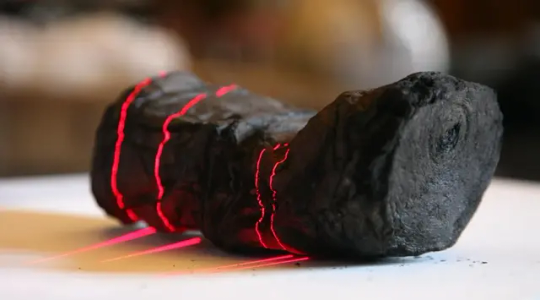
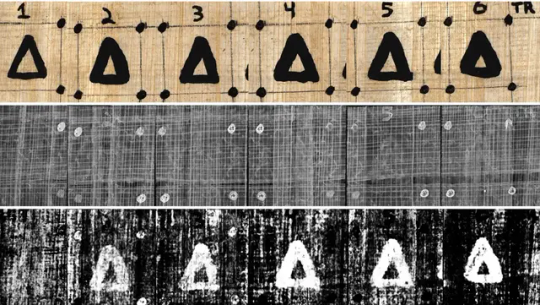

Historians already knew that Plato, the famous student of Socrates who wrote down his teacher's philosophies as well as his own, was buried at the Academy, which the Roman general Sulla destroyed in 86 B.C. But researchers weren't sure exactly where on the school's grounds that Plato, who died in Athens in 348 or 347 B.C., had been laid to rest.
However, with advances in technology, researchers were able to employ a variety of cutting-edge techniques including infrared and ultraviolet optical imaging, thermal imaging and tomography to read the ancient papyrus, which is now part of the collection at the National Library of Naples.
So far, researchers have identified 1,000 words, or roughly 30% of the text written by Philodemus.
"Among the most important news, we read that Plato was buried in the garden reserved for him (a private area intended for the Platonic school) of the Academy in Athens, near the so-called Museion or sacellum sacred to the Muses," researchers wrote in the statement. "Until now it was only known that he was buried generically in the Academy."




The text also detailed how Plato was "sold into slavery" sometime between 404 and 399 B.C. (It was previously thought that this occurred in 387 B.C.)
Another part of the translated text describes a dialogue between characters, in which Plato shows disdain for the musical and rhythmic abilities of a barbarian musician from Thrace, according to the statement.
This isn't the first time that researchers have used AI to read ancient scrolls that survived Mount Vesuvius's eruption. Earlier this year, researchers deciphered a different scroll that was charred during the volcanic eruption at a nearby villa that once belonged to Julius Caesar's father-in-law.
By Jennifer Nalewicki.


#Plato#Herculaneum Scrolls Reveal Plato's Burial Place#Herculaneum#Pompeii#Philodemus of Gadara#History of the Academy#The Academy#Plato's Academy#the Platonic Academy#the Academic School#athens greece#mount vesuvius#roman dictator sulla#ancient texts#ancient artifacts#archeology#archeolgst#history#history news#ancient history#ancient culture#ancient greece#greek history#roman history#roman empire
80 notes
·
View notes
Text
I keep seeing posts about how snakes have bad vision and Crowley probably can't see the stars and that made me so sad. So instead of answering emails at work this morning, I looked up videos about snakes to figure out how they see stuff and I learned so much and the implications of these facts are ABSOLUTELY DELIGHTFUL:
(I'm putting it all under the cut because the post got long lol)
1. Snakes with vertical slits in their eyes are nocturnal.
2. Research suggests that snakes have the necessary receptors in their eyes to see mostly blues and greens (and any colors that are made up of those two) in the daytime and monochromatic (gray-scale essentially) in the night time. For reference, human color receptors in the daytime are red, green, and blue. For night it's monochromatic as well.
3. Some snakes have 'heat pits' along their pretty (pretty is subjective not a fact sorry) mouths that help them sense infrared light. The visual and infrared cues are overlaid in the optic parts of the brain. (Truly this is the coolest thing I've learned about snakes and I highly recommend reading the Wikipedia page about it, it is SO COOL). The heat pits work in such a way that if they don't cool down the receptors back to a 'thermal neutral' state (usually by providing extra oxygen to them) the snake will see afterimages even if whatever was giving off the infrared is removed.
4. Snakes smell with their tongues by picking up odor particles and then putting their tongue into little holes along the roof of their mouth where they have this thing called the "Jacobson's organ" that has receptors that can register the smells. To give you a sense of how sophisticated this sense of smell is, apparently snakes can tell which eggs have developing embryos in them in order to avoid them because it's easier to eat undeveloped eggs. (ISNT THAT INCREDIBLE?!?!)
IMPLICATIONS OF THESE FACTS:
1. Crowley can see at night because he's got them nocturnal snake eyes.
2. Crowley PROBABLY THOUGHT HIS HAIR TURNED BLACK WHEN HE FELL AND HE SAW HIS WINGS SORTA MATCHED. And unless someone has told him his hair is still red MAYBE HE STILL DOESNT KNOW
3. (Part 1) Nothing pisses me off more than that they didn't give Crowley's snake design heat pits along the lips because that would be so freaking cool to see in fanart of Crowley in like 'true form' or whatever cuz it would make him seem more "otherworldly" or "monstrous" but whatever. I'll forgive the designers because the heat pits he does have imply that he's a pit viper and also they're not visible on his human form (unless they're inside his nostrils?). Which means they're probably covered and don't cool back to 'thermal-neutral' properly so Crowley probably sees after images all the goddamn time (I'm gonna fucking write the saddest angstiest post season 2 fanfic for good omens called Afterimage BASED ON THIS FACT ALONE).
3. (part 2) because of how the regular vision and infrared vision are overlaid, anything that's warm/hot in temperature, like let's say an angel, probably looks like it's glowing. HELLO FANFIC AUTHORS WHERE ARE YOU?!? BLUSHING/FLUSHED AZIRAPHALE GLOWS BRIGHTER THAN NORMAL TO CROWLEY HELLO?!?!
4. When Aziraphale and Crowley kiss with tongue IF we give Crowley a Jacobson's organ, he would be OVERWHELMED WITH AZIRAPHALE. Imagine in every regular human sense, plus snake senses all of it is jUST AZIRAPHALE. Holy CRAP GUYS PLEASE (also like monsterfuckers/true form enthusiasts, the Jacobson's organ is just another fun snake feature you can include for funsies in your fanworks).
#good omens#good omens 2#go2#good omens 2 spoilers#go2 spoilers#good omens spoilers#if this is the post that categorizes me as a momsterfucker then so be it#im with good company
142 notes
·
View notes
Note
you mentioned in a previous ask that snakes use heat pits to sense infrared light. so are the heat pits like, modified retinas with IR sensitive pigments in them? or are they actually just particularly sensitive to heat?
They're not visual organs at all, they detect infrared signatures but not infrared light. They just pick up on thermal radiation signatures.
Here's a diagram of how heat pits are set up - they're openings set into the snake's lips or cheeks, and inside is a membrane that sends information on infrared signatures to the snake's brain when it comes into contact with the air.

Pit organs are fascinating, and the details of how exactly they work are unfortunately still not super well understood. Even though they're not visual organs, the information might travel to the snake's brain in a way that gives them a "snapshot" image of nearby infrared signatures!
They're weird, unique organs! I think part of what makes them so interesting is that humans just have nothing like them, so it can be tricky to conceptualize how they help snakes interpret the world.

266 notes
·
View notes
Text
A shallowish dive into some pits.
The pit organ of a viper is what is responsible for its ability to detect body heat via infrared (IR) light. Whilst IR detection has evolved multiple times in snakes, the pit organ is far and away the most sensitive and specialised of the bunch. The snake is able to detect thermal differences of just 0.003C, which is wild, because some of the best available cryogenic IR sensors that we've made are apparently sensitive to differences of around 0.01C (although I don't know much about thermal imaging so please someone correct me if I'm wrong).
The receptor that is found in the pit organ is known as TRPA1 (it stands for something technical and boring, cellular biology has never been my jam), and it's expressed in incredibly high amounts in the Trigeminal Ganglion of snakes, which is the main nerve that connects to the face.

ID: A close up image of the face of a rattlesnake. Its scales are a mixture of brown and yellow tones. It looks cool.
Some people theorise that the pit organ didn't initially evolve for hunting, but rather predator detection and thermoregulation. Studies of pit vipers and true vipers have found that pit vipers were much better at finding spots to warm up in than their non-pitty relatives. So the pit organ might have evolved for a more general use rather than the predatory one we first thought.
But you know what's interesting? In mammals, TRPA1 is actually cold receptor, as well as one that's responsible for itching. What's more, it's commonly known as the wasabi receptor, because that's what the chemicals in wasabi bind to to give us that characteristic kick. I guess its link to our trigeminal nerve is why it gets us when it's in our face but not really anywhere else, unlike the spice you find in chillis.

ID: An image of an Australian Black Rock Scorpion sat upon some light coloured wood. The scorpion is dark brown in colour with lighter coloured legs. Both its sting and claws are somewhat raised.
ALSO, I just found this out as I was doing a bit more research, but since TRPA1 is also a receptor involved in sensing pain, it's a target for a toxin called the Wasabi Toxin, produced by the Australian Black Rock Scorpion. The toxin forces the channel open, making the affected area hypersensitive to heat and touch, but doesn't make it swell up.
Anyway, this was a bit more of a ramble than my usual posts, I just thought it was interesting how this one receptor is linked to so many different things, and how it's used in such a variety of ways.
37 notes
·
View notes
Text
Thermographic Inspection Services | ThermoElite - Leading Experts in Thermal Imaging
Ensure safety and efficiency with ThermoElite's professional thermographic inspection services. Our expert thermal imaging detects hidden issues in electrical systems, building structures, and more. Trust ThermoElite for accurate and reliable thermal inspections. Contact us today!

#Thermographic Inspection#Thermal Imaging Services#ThermoElite Inspections#Infrared Thermography#Building and Electrical Inspections
0 notes
Text
Quirks and features of the James Webb Space Telescope

The James Webb Space Telescope (JWST) is a ten billion dollar space telescope that weighs 14,000 pounds, is the size of a bus, and took decades to construct. It's been in the news recently, you might have heard about it.
The development, launch and deployment of the JWST were fraught with unexpected setbacks, terror and frights, 344 "single-point failures", any one of which that, if they failed during deployment, could doom the entire spacecraft to uselessness, since it orbits far out beyond where any current manned spacecraft could even attempt a repair job.
The fact that it came online as smoothly as it did was something of a surprise to the people in charge. Given the miracle of it making it to space at all, the press coverage of JWST has focused on the positives. But a stroll through the JWST user documentation by a curious reader reveals much that is interesting, or interestingly broken. Such as..
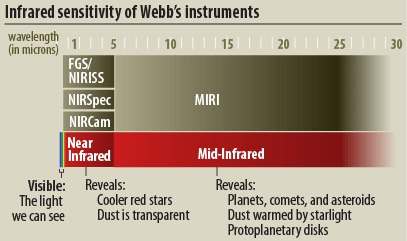
Fun and games with infrared
Specifically, the JWST is an infrared telescope, designed to collect light that's redder than red. The two dedicated imaging instruments are the Near Infrared Camera (NIRCam) collecting light from 0.6 micrometers to 5.0 micrometers and the Mid-Infrared Instrument (MIRI) collecting light from 5.6 micrometers to 25.5 micrometers. (Though with significant light collected past 25.5 um by filter F2550W)
The wonderful thing about infrared astronomy is that everything emits blackbody radiation, and the hotter it is the more infrared it emits. The unfortunate thing about infrared astronomy is that everything emits blackbody radiation, including your telescope, and self-emission from your telescope can swamp the faint signal from astronomical sources. (Like building a camera out of glowsticks.)
The equilibrium temperature for an object in Earth orbit is about 300 Kelvin. (26C) Everything on the other side of the sunshield passively cools down to 40K, and MIRI is actively cooled by the cryocooler down to a chilly 6K (-267C, -449F) This extends MIRI's seeing range deeper into infrared.
But the mirror is still warm! At the far end, MIRI is significantly compromised by thermal self-emission: (Note log scale!)
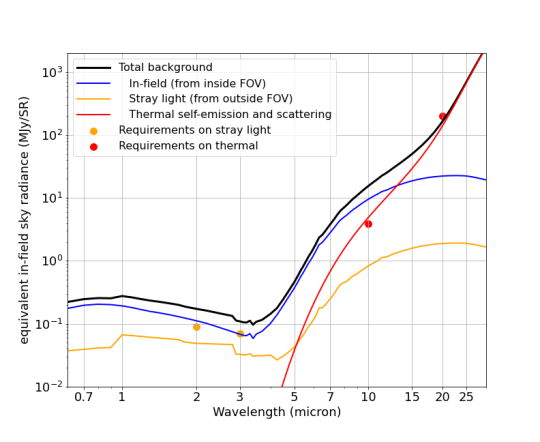
This is more graphically illustrated by one of the MIRI commissioning images:

Check out that background glare!
(This is somewhat unfair: the calibration target here is a star, which emits comparatively little light in far-infrared. MIRI is really meant for nebulae and extra-galactic high-redshift objects)
("Why not actively cool the mirror?" Mechanical cryocoolers operate on the very limit of what heat engines are capable of. The MIRI cryocooler draws a fat 180 watts to move 78 milliwatts of heat. Previous infrared telescopes used a fixed amount of expendable coolant (liquid helium or solid hydrogen) to cool the entire instrument package... at the cost of a much smaller primary mirror and a telescope that flat out just stopped working when it ran out of coolant.)
There's something else you might notice about the above series of photographs...
Thanks a lot, Lord Rayleigh
John William Strutt, 3rd Baron Rayleigh was a typical early physicist in that he has a great big pile of "discoveries" by virtue of being the first person to 1) notice something and 2) actually write it down. One of them is the fundamental theorem for the angular resolution of an optical system, the Rayleigh criterion. It is dead simple:

Resolution is roughly equal to 1.22 times the wavelength of the light you're looking at, divided by the diameter of the aperture. Bigger the opening at the front of light bucket, the higher the resolution. Smaller the wavelength of light, the higher the resolution.
(Fun fact: the former Arecibo radio observatory, once the largest single telescope in the world with a 305 meter wide dish, had about the same angular resolution in radio waves as the human eye does in visible light.)
You can imagine the effect this has on an infrared telescope. And sure enough, in the user documentation for the two imaging sensors, it states a pixel scale of 0.031 arcseconds for 0.6 to 2.3 micrometers light wavelength, 0.063 arcsec/px for 2.4-5.0 µm, and a squishy 0.11 arcsec/px for 5.6-25.5 µm.
But this is just how many pixels are on the detector. The resolution gets much worse at long wavelengths, as you can see in the commissioning image, where the extra pixels oversample a progressively vaguer blob. The Rayleigh criterion holds that the 6.5 meter wide JWST primary mirror should manage 0.206 arcsec at 5.32 µm, falling to 0.42 arcsec at 10.85 µm, 0.747 arcsec at 19.29 µm, and an unfortunate 1.014 arcsec at 26.2 µm. One wonders why the designers went to heroic lengths to cool MIRI down to 7 kelvin, instead of using that cryocooler mass and power budget for more detector surface area.
Knowing this, you can spot how the JWST's press team works around the limitations of the telescope. Like how a "look at how good our infrared telescope" commissioning photo happens to use the 7.7 µm mode:

Or how if you browse the photos on the webbtelescope.org site, you will see lots of NIRcam output in the "oooh, ah, new desktop background" category, but not so much MIRI.
(Another amusing detail of MIRI is that bright objects leave afterimages ("latents") on the sensor, so once a week they warm the sensor up to a tropical 20 kelvin before cooling it down again, a "MIRI anneal". You can see when anneals are performed, as well as what the telescope is looking at right now, by viewing the public schedule.)
But this is Webb operating right up to its full specifications. How about something that's actually broken?

NIRSpec my beloved
The Near-Infrared Spectrograph (NIRSpec) instrument takes incoming light and runs it through a diffraction grating to produce a spectrum. When scientists say that the Sun is 0.77% oxygen, 0.29% carbon, etc, it's not because someone flew a spacecraft over to it and collected a bucket of solar plasma, it's because you can look at the absorption lines in the spectra to figure out its composition.
Spectrometry is also used to measure redshift, a close proxy to distance. When a press release says that a galaxy is "ten million lightyears away", it's not because NASA has a really long tape measure they haven't told anyone about, it's because a spectrometer measured how much cosmological redshift has moved a spectrum line. Naturally, it's not quite as easy as pointing a sensor at a object and getting back a single, unambiguous result. Distant objects are also dim objects, so the spectra will be noisy and chewed up by dust and other contamination its endured in the millions of years its traveled to arrive at our telescopes. Bleeding edge astronomy is thus the practice of designing statistical models to fit to noisy, fragmented data, and then arguing with other astronomers about r^2.
In any event, it's a handy thing to have on a telescope. Naturally, JWST has more than one. In fact every instrument has a spectroscopy mode. Besides the dedicated NIRISS and NIRSpec instruments, both NIRcam and MIRI include diffraction gratings in their filter wheels that smear out incoming light, like looking through a prism:
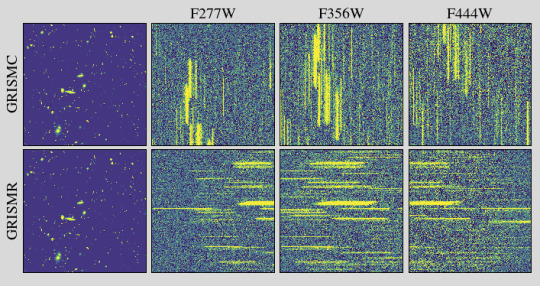
Pointing the JWST at an object is relatively expensive, since it requires rotating ("slewing") the entire darn spacecraft, and an amusingly complex alignment procedure with the fine guidance sensor and fine steering mirror. Considering how long it would take to shoot a hundred spectra with a conventional fixed slit rigidly mounted to the telescope frame, you can see the appeal of gathering a hundred spectra in a single exposure with "slitless" spectroscopy.
(Longtime space telescope nerds might hear the word "slewing" and involuntarily twitch, recalling that the reaction wheels and gyroscopes were a problem point on the Hubble, requiring several servicing missions, and also significantly affecting operations on the Kepler space telescope. Fortunately, JWST switched to a gyroscope type that has no moving parts, and used some mass budget to install six reaction wheels, up from Hubble's four, giving it three spares.)
You can also see the big downside in the image above, which is there's a hard tradeoff between how long a spectrum can be (and thus its resolution!) before it'll overlap its neighbors and be useless. Most of the slitless modes therefore have two gratings at two different angles, (GRISMR and GRISMC above) but wouldn't it great if you could just block out all that other light?

Thus, the Micro Shutter Array, as seen above. The best of both worlds! Capture many spectra at the same time, while blocking off light you don't want from contaminating the field, using a configurable array of nearly a quarter million microscopic, individually actuated moving shutters.
Lots and lots and lots of tiny little moving parts, installed in the guts of a spacecraft that's orbiting out past the Moon, impossible to access or replace.
Yeah, a bunch of them broke:

When it was handed over to NASA for installation into Webb in 2007, the MSA already had 150 shutters that no longer responded to opening commands in just one of the four submodules.
By the time JWST emerged from commissioning and was declared fully operational in 2022, 15,893 shutters, 7% of the total, had "failed closed." Hilariously, 904 of those failed during post-launch testing, and the authors of that paper note that, on average, if you tell 100 shutters to close, 4 of them will jam shut and no longer work.
This is unfortunate, but fairly easy to work around. What's worse are the shutters that are stuck open:


These permanently open shutters then compromise big chunks of the sensor. Commissioning testing jammed two more of them open, taking the total up to 22. You can imagine that if a few dozen more of these fail-open during routine operation then the entire microshutter array observation mode won't be much more useful than regular slitless spectrography.
And this, right here, sums up the essentially "interim" nature of JWST. After all, it was only supposed to cost $500 million and take a mere nine years from design to launch. All becomes clear in that light. Why give it a shutter array that falls apart in use? Why have the mirror exposed to space, where it gets hit with micrometeoroids? Why only design it to carry ten years worth of fuel? Because it was supposed to be half the price of Hubble!
The 90s was the era of "faster, better, cheaper". JWST was going to be an incremental improvement on a long series of previous infrared telescopes, and a stepping stone to the next one. It wasn't supposed to be an eternal monument to Science, and a financial black hole consuming NASA's entire budget.
So what went wrong?
We shouldn't have built one JWST.
Those 344 single points of failure. Any single one of them can end the mission. There's just one telescope, no backups, no trying again. Bureaucrats are harshly punished for failure, lightly rewarded for success. It's always easier to wait, do more tests, delay the schedule a bit more at a hint of trouble. Engineers can get you to 90% reliable no problem, but getting to 99% reliable takes another decade and nine billion more dollars.
Our techne is just bad at producing flawless machines first try. For the price of one reliable JWST we could have put twenty into orbit... but the first five would have been embarrassing failures. Spars sticking in place, sunshields jamming, thrusters misfiring. To save the shame of $0.5 billion wasted, NASA happily spent $9.5 billion. Why not? Because money spent is invisible, but failure is painfully apparent.
A critical third party can draw unflattering parallels. The crowning achievement of NASA, the Moon Landing... required eleven Apollo launches and twenty Surveyor launches before a single man set foot on lunar regolith! Quite a few of those spacecraft pancaked into the Moon and exploded on the launchpad before we figured out this "space" thing. Three men died! But NASA was on a hard deadline, with a fixed budget, and the only way to get a home run is to take a lot of swings at the ball.
Another comparison is the Space Launch System, NASA's attempt to make the Saturn V again. So far $27 billion has been lit on fire to put exactly one test load into orbit, with the primary contractor now desperate to get out of its contact. Slow, careful, incremental development has completely failed to produce a working launch system.
Meanwhile, SpaceX produced a series of public, embarrassing failures... resulting in the world's only reusable launch system, and as a result has put far more mass into orbit than any country in the world.
The only way to develop a flight system is flight tests.
Space telescope deploy mechanisms meant to work in zero gravity can't be tested on the ground.
They can only be tested in space.
NASA administrators who didn't work during Apollo are too stupid to understand this. Fire them all!
These geriatrics have happily sacrificed science in order to play it safe and secure their own easy retirement. Do we want 15 risky JWST telescopes by 2010, or do we want one reliable one by 2022? The answer is obvious!

For the money we wasted making Webb more reliable, we could have launched a space telescope far outside the disk of dust in the inner solar system, allowing it to see deeper into space than Webb ever could. ESA put an astrometry space telescope just outside Earth orbit, measuring angles between stellar objects, which is the only way to directly measure the distance to the stars. Great first step. The obvious next step is to send more of these telescopes out past Neptune's orbit, to capture better observations with a vastly larger baseline, something that can never be done by an Earthly observatory. Are there any plans to do this? No!
Space exploration is paralyzed by boomers, mired in the mental tarpit of the 1970s, where each gram to orbit is terribly expensive and must be counted on punched cards and summed with slide rules. Meanwhile, SpaceX Starship is on its way to orbit, and each one can carry sixteen JWSTs with room to spare!
The old paradigm is done. Telescopes don't need folding mirrors and exotic materials, they need to be mass produced. There is no excuse not to have a hundred more JWST-class telescopes lined up next to the Texas launch pad waiting for Starship to come online. But as far as I know not a single space mission even mentions it-- that's how afraid they are of risk!
The JWST, with its myriad of fragile components and its staggering price tag, stands as a monument not to our ingenuity but to our inability to let go of outdated ideals.
We must abandon the notion that space is a realm reserved for the flawless and the infallible. Instead, we should embrace the chaos, the unpredictability, the sheer messiness of exploration. Let us launch a thousand telescopes, each a patchwork of parts, each destined to fail in its own spectacular way. For it is only in this embrace of the ephemeral that we can find out what actually works!
Let the JWST be the last of its kind, a relic of a bygone era. The future is unwritten, and it is ours to fill with a symphony of failures, each note a step closer to the stars.
279 notes
·
View notes